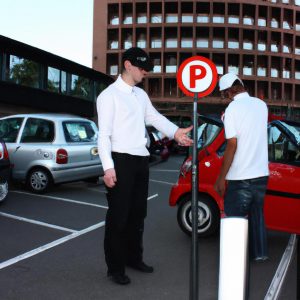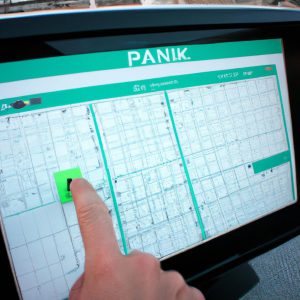
Imagine arriving at a luxurious hotel for an exquisite dining experience, only to be greeted by the perplexing maze of parking signage and directions. In this scenario, a clear understanding of valet parking procedures becomes paramount in ensuring a seamless and enjoyable visit. This article aims to provide a comprehensive guide on navigating the intricacies of parking signage and directions specifically related to valet services at hotels and restaurants.
One hypothetical example that illustrates the importance of comprehending parking signage and directions is as follows: Imagine a couple planning their anniversary dinner at a renowned fine dining restaurant nestled within a bustling city center. As they approach their destination, they find themselves confronted with an array of signs directing them towards various parking options. Without proper guidance, they may inadvertently choose an unsuitable option, leading to frustration and potential delays before embarking on what should have been an enchanting evening.
In order to avoid such scenarios, it is essential for guests to familiarize themselves with the specific signage used by establishments offering valet parking services. By gaining insight into these visual cues, visitors can confidently follow instructions while avoiding confusion or unnecessary detours. Moreover, understanding how directional signs are strategically placed throughout the premises enables individuals to navigate efficiently between different areas such as drop-off zones, pick-up locations, and designated parking areas.
When it comes to valet parking signage, there are a few common symbols and terms to be aware of. The most prominent sign is typically the one indicating the presence of valet parking services. This sign often features the word “Valet” along with an arrow pointing in the direction of the drop-off zone. It is crucial to keep an eye out for this sign as it indicates where guests should proceed to hand over their vehicles to the valet attendants.
Once at the drop-off zone, guests may encounter additional signs indicating specific instructions or guidelines. These signs could include directions on how to turn off the engine, reminders to remove personal belongings from the vehicle, or even information about any additional fees associated with valet parking. Paying close attention to these signs ensures that guests comply with any necessary procedures and helps maintain a smooth flow of traffic in busy areas.
After handing over their keys and receiving a claim ticket from the valet attendant, guests will likely need directions on how to reach their dining destination or navigate back to their vehicle later on. In this case, directional signs play a vital role in guiding individuals through lobbies, hallways, elevators, and staircases towards various dining venues within the hotel or restaurant. These signs often feature arrows pointing in different directions along with clear labels indicating specific restaurants or dining areas.
Lastly, when it is time to depart and retrieve their vehicles, guests should look for pick-up location signs directing them towards where they can collect their cars from the valet attendants. These signs are usually placed near exits or entrances specifically designated for valet service customers. Following these signs ensures that guests can efficiently locate their vehicles without any unnecessary delays.
In conclusion, understanding parking signage and directions pertaining to valet services at hotels and restaurants is essential for a seamless and enjoyable experience. Familiarizing oneself with common symbols related to valet parking, following instructions at drop-off zones, and paying attention to directional signs within the premises ensures that guests can navigate effortlessly between different areas and retrieve their vehicles with ease. By being mindful of parking signage and directions, individuals can make the most out of their visit to a luxurious hotel or restaurant without getting lost or encountering unnecessary frustrations along the way.
Types of parking signs used for valet parking
Types of parking signs used for valet parking
Imagine arriving at a luxurious hotel after a long day of travel, eager to unwind and relax. As you pull up to the entrance, you are greeted by a friendly valet attendant who swiftly takes your car keys with a warm smile. Promptly, he hands you a numbered ticket and assures you that your vehicle will be safely parked until needed. This seamless process is made possible through the use of various types of parking signs specifically designed for valet services.
One common type of signage utilized in valet parking is the “Valet Parking Only” sign. Positioned strategically near the drop-off area, this sign clearly indicates that only vehicles being entrusted to the valet service may park there temporarily. Its bold lettering and distinctive color scheme help distinguish it from other signage around the premises, ensuring that guests can easily identify where they should leave their cars.
Another important sign frequently employed in valet operations is the “No Parking” sign. Placed in areas designated solely for pedestrians or emergency access routes, these signs effectively communicate that no vehicles are permitted to park in those specific spots. By using clear symbols such as crossed-out cars or tow truck icons alongside concise text, these signs prevent unauthorized individuals from obstructing designated pathways.
To further enhance organization and efficiency within busy valet areas, many establishments make use of directional signs. These signs provide guidance on how drivers should navigate through various sections of the parking lot when dropping off or picking up their vehicles. Arrows indicating one-way traffic flow and labels denoting pick-up points ensure smooth movement within limited spaces while minimizing congestion.
In addition to these commonly seen signs, some establishments go above and beyond by incorporating digital displays into their valet parking systems. These dynamic screens not only display general information about available spaces but also provide real-time updates on wait times and availability status. By utilizing technology in this manner, hotels and restaurants aim to enhance the overall customer experience and streamline their valet operations.
Clear, visible signage plays a vital role in ensuring an efficient valet parking process. From indicating exclusive areas for valet services to directing traffic flow, these signs assist both drivers and attendants in navigating busy parking lots seamlessly. In the following section, we will explore further the importance of such signage and how it contributes to a successful valet operation.
The importance of clear and visible signage
In the previous section, we explored the various types of parking signs commonly used in valet parking. Now, let us delve into the importance of clear and visible signage in ensuring a smooth valet parking experience.
Imagine arriving at a luxurious hotel for a special evening out. As you approach the entrance, you notice a neatly designed sign that reads “Valet Parking Available.” This simple yet effective sign immediately signals to you that there is an option to have your vehicle parked by professional attendants. Such well-placed and clearly worded signs play a crucial role in guiding guests towards the designated valet parking area.
To emphasize the significance of clear signage further, let’s consider some key points:
- Visibility: Signs should be prominently placed at strategic locations where they can easily catch the attention of approaching drivers.
- Clarity: Signage must use concise language and universally understood symbols or icons to convey information without ambiguity.
- Directional arrows: Clear directional arrows on signs help guide drivers towards the correct entrance and exit points within the parking area.
- Color contrast: The colors chosen for signage should provide high visibility even from a distance, especially during low-light conditions.
- Frustration can arise when unclear signage leads to confusion about where to drop off vehicles.
- Anxiety may increase if inadequate directions result in difficulty finding one’s way back to retrieve their car.
- Relief sets in when well-designed signage helps navigate effortlessly through unfamiliar areas.
- Appreciation builds as visually appealing signs enhance overall aesthetics while serving their practical purpose.
Now let’s take a look at a table showcasing different elements that contribute to effective valet parking signage:
| Element | Importance | Impact |
|---|---|---|
| Placement | Ensures visibility; directs attention | Draws drivers’ focus toward valet service |
| Language | Minimizes confusion; facilitates quick comprehension | Allows drivers to easily understand and follow instructions |
| Symbols/Icons | Aids universal understanding; transcends language barriers | Assists international visitors or those with limited English proficiency |
| Lighting | Enhances visibility during low-light conditions; ensures legibility | Enables clear reading of signs, day or night |
In conclusion, well-designed parking signage is a vital component of valet services. Clear and visible signs not only provide guidance but also contribute to the overall experience by reducing stress and enhancing convenience for guests.
Transitioning into the subsequent section about “How to navigate parking areas and follow directions,” let us now delve into practical tips that can help make your valet parking experience seamless.
How to navigate parking areas and follow directions
Having understood the significance of clear and visible signage, let us now delve into the critical aspect of navigating parking areas and following directions. To illustrate this further, consider a hypothetical scenario where you arrive at an upscale hotel for dinner with your friends. As you approach the entrance, you notice multiple valet parking signs directing you to different areas. Without proper guidance, it could become confusing to find the designated parking spot or follow instructions effectively.
Paragraph 1:
To ensure a smooth experience in navigating parking areas, there are several key considerations one should keep in mind. Firstly, take note of any directional arrows painted on the ground or displayed on signage – they guide drivers towards specific lanes or locations within the parking area. Additionally, be attentive to color-coded markings that distinguish between various sections such as guest parking, reserved spots, or spaces exclusively meant for disabled individuals. These visual cues aid not only in efficient navigation but also promote safety by preventing misplacement of vehicles.
- Clear directional arrows provide easy guidance.
- Color-coded markings help differentiate parking sections.
- Visible signage ensures drivers can easily locate designated spots.
- Adequate lighting enhances visibility during nighttime operations.
Paragraph 2:
Apart from relying solely on visual cues, it is crucial to pay attention to verbal instructions provided by attendants stationed nearby. Attendants play a pivotal role in ensuring seamless traffic flow and assisting customers throughout their visit. By attentively listening and promptly following their directions regarding which lane to enter or where to park your vehicle temporarily before handing over your keys, you contribute to maintaining orderliness and minimizing congestion within the premises.
Table (3 columns x 4 rows):
| Parking Area | Color Code | Designated Use |
|---|---|---|
| Guests | Green | General visitors’ temporary parking |
| Reserved | Blue | Reserved for specific individuals |
| Disabled | Yellow | Parking spaces exclusively for disabled |
| Valet | Red | Temporary parking before handing keys |
Paragraph 3:
By familiarizing yourself with the layout of the parking area and adhering to directions given by attendants, you can ensure a hassle-free experience when it comes to valet parking. Maintaining patience and attentiveness not only facilitates efficient traffic management but also enhances overall safety within the premises. With these considerations in mind, let us now explore common symbols and instructions found on valet parking signs.
Transition sentence to subsequent section:
With an understanding of how to navigate parking areas effectively, we can now delve into examining common symbols and instructions commonly found on valet parking signs.
Common symbols and instructions on valet parking signs
Imagine this scenario: You have just arrived at a luxurious hotel for a well-deserved vacation. As you pull into the parking lot, you notice an array of signs directing you towards the valet parking area. Navigating through these areas effectively requires understanding various symbols and following specific instructions. This section will provide essential guidance on how to navigate parking areas and follow directions when utilizing valet parking services.
To ensure a smooth experience, consider the following tips:
-
Pay attention to signage: Valet parking areas are typically marked by clear signs featuring recognizable symbols such as arrows pointing in the direction of the drop-off zone or indicating where to collect your vehicle later. These signs play a crucial role in guiding drivers through the process efficiently.
-
Follow designated lanes: Often, valet parking areas have separate lanes for entering and exiting vehicles. Make sure to adhere to these designated lanes to prevent any confusion or congestion.
-
Observe speed limits: It is common for hotels and restaurants with valet services to enforce reduced speed limits within their premises. Adhering to these limits ensures both driver and pedestrian safety while maintaining orderliness in busy parking lots.
-
Communicate with attendants: When approaching the drop-off zone, it is important to communicate with valet attendants clearly so they can assist you promptly. Roll down your window, greet them courteously, and provide any necessary information about your stay or special requests that may affect your vehicle’s handling (e.g., delicate cargo).
By following these guidelines, navigating through parking areas becomes effortless, ensuring a hassle-free valet service experience.
| Symbol | Meaning | Example |
|---|---|---|
| 🔽 | Drop-off Zone | The symbol indicates where passengers should exit their vehicles |
| 🚗 | Vehicle Collection Area | This symbol denotes the location where customers retrieve their cars |
| 🚧 | Construction Zone | This symbol alerts drivers to areas under construction or renovation |
| ☝️ | One-Way Traffic | The sign indicates the direction of traffic flow within the parking area |
In this section, we have discussed how to navigate through valet parking areas by paying attention to signage, following designated lanes, observing speed limits, and communicating effectively with attendants. By adhering to these guidelines, you can ensure a seamless experience when utilizing valet services.
Tips for finding and utilizing valet parking services
Parking Signage and Directions: A Guide to Valet Parking at Hotels and Restaurants
Common symbols and instructions on valet parking signs play a crucial role in ensuring the smooth operation of these services. By understanding and following these signs, both drivers and valets can navigate the process efficiently. For instance, imagine a busy hotel where multiple guests arrive simultaneously, all requiring valet parking. Clear signage indicating drop-off zones helps direct vehicles to designated areas, preventing congestion and confusion.
To make this information easily comprehensible, here are some common symbols found on valet parking signs:
- An arrow pointing downward indicates the location of the drop-off zone.
- A car icon with an accompanying dollar sign signifies that there is a fee for using the valet service.
- A key symbol represents that keys must be handed over to the attendant.
- The letters “VP” (Valet Parking) serve as a general indicator for the availability of such services.
These symbols effectively convey important information at a glance, allowing drivers to quickly understand what they need to do upon arrival. Additionally, clear instructions may accompany these symbols to provide further guidance. For example:
- Pull forward: Drivers should continue moving their vehicle until instructed otherwise by the attendant.
- Hand over keys: If required, drivers must give their keys to the valet attendant.
- Collect ticket: In exchange for handing over their vehicle, drivers receive a ticket or receipt that serves as proof of ownership.
- Retrieve vehicle: When ready to leave, drivers present their ticket or receipt to retrieve their vehicle from the valet.
The table below provides an overview of typical symbols and corresponding instructions commonly seen on valet parking signs:
| Symbol | Instruction |
|---|---|
| Arrow pointing downward | Proceed towards drop-off zone |
| Car icon with dollar sign | Expect a fee for using valet service |
| Key symbol | Be prepared to hand over your keys |
| VP (Valet Parking) | Valet parking service available |
By familiarizing themselves with these symbols and instructions, drivers can navigate the valet parking process smoothly. Ensuring a smooth experience with proper communication and understanding is essential for both guests and establishments alike. In the subsequent section about “Ensuring a smooth experience with proper communication and understanding,” we will explore strategies that hotels and restaurants can employ to enhance their valet services further.
Ensuring a smooth experience with proper communication and understanding
Transitioning from the previous section on tips for utilizing valet parking services, let us now delve into the importance of proper communication and understanding to ensure a smooth experience. To illustrate this, consider a hypothetical scenario where a guest arrives at a hotel’s valet parking area. The guest is unfamiliar with the process and lacks clear directions or signage. As a result, they become frustrated and confused, leading to delays and potential dissatisfaction.
To avoid such scenarios, effective communication between guests and valet attendants plays a critical role. Firstly, hotels and restaurants should invest in clear and visible signage that provides explicit instructions on how to utilize their valet parking service. These signs can be strategically placed near entrances or along driveways to guide guests effortlessly towards the designated drop-off points. Additionally, digital displays or electronic boards may offer real-time information about available spaces or any temporary changes in traffic flow.
Furthermore, assisting guests through verbal communication is equally important. Valet attendants should provide accurate information regarding parking fees, retrieval procedures, and estimated wait times when checking in vehicles. Employing friendly customer service skills while answering queries can significantly enhance the overall experience for patrons.
To emphasize the significance of proper communication and understanding within valet parking services further, here are some key considerations:
- Clear Signage: Ensure prominent placement of signs directing guests towards designated areas.
- Attendant Communication Skills: Train staff to effectively communicate relevant information without overwhelming guests.
- Real-Time Information: Utilize technology to update customers about availability or any changes in parking arrangements promptly.
- Multilingual Support: Consider providing multilingual signage or hiring bilingual staff members to accommodate diverse clientele.
| Factors | Importance |
|---|---|
| Clear Signage | High |
| Effective Communication Skills | High |
| Real-Time Information | Moderate |
| Multilingual Support | Moderate |
In conclusion, the success of valet parking services relies heavily on proper communication and understanding. Clear signage, effective verbal communication, real-time information updates, and multilingual support all contribute to a smoother overall experience for guests. By prioritizing these aspects, hotels and restaurants can enhance customer satisfaction levels while ensuring efficient operations within their valet parking facilities.





